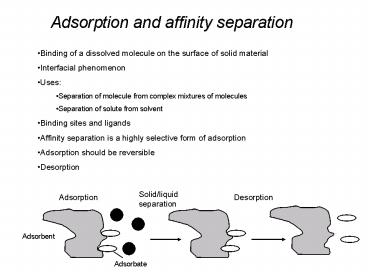Adsorption and affinity separation - PowerPoint PPT Presentation
1 / 10
Title:
Adsorption and affinity separation
Description:
Pulse or elution chromatography. Adsorbents. Particulate. Natural or ... Desorption or elution. High salt concentration. Shielding of electrostatic interactions ... – PowerPoint PPT presentation
Number of Views:348
Avg rating:3.0/5.0
Title: Adsorption and affinity separation
1
Adsorption and affinity separation
- Binding of a dissolved molecule on the surface of
solid material - Interfacial phenomenon
- Uses
- Separation of molecule from complex mixtures of
molecules - Separation of solute from solvent
- Binding sites and ligands
- Affinity separation is a highly selective form of
adsorption - Adsorption should be reversible
- Desorption
Solid/liquid separation
Adsorption
Desorption
Adsorbent
Adsorbate
2
Selectivity
- Molecular weight or size of solute
- Shape of the molecule and the binding site/ligand
- Polarity of the molecules and the adsorbent
- Electrostatic charge on the molecule and the
adsorbent
Physical properties
Chemical properties
- Advantages
- High selectivity of separation (e.g. affinity
adsorption) - Ability to handle very dilute solute
concentrations - Disadvantages
- Adsorption is a surface phenomenon therefore the
interior of the adsorbent material is not
involved - Batch or semi-batch operations generally have to
be used due to the adsorption/desorption cycle - Adsorption may results in loss of biological
activity - Adsorbents can get fouled by biological material
3
Applications
- Protein fractionation
- Industrial enzymes
- Therapeutic proteins
- Food proteins
- Nucleic acid separation
- Plasmid purification
- RNA purification
- Antibiotic purification
- Bacitracin
- Streptomycin
- Biomedical analysis
- Pulse or elution chromatography
4
Adsorbents
- Particulate
- Natural or synthetic material
- Amorphous or microcrystalline structures
- High specific surface area
- Commonly used adsorbents
- Cellulose based
- Silica gel based
- Synthetic resins
- Agarose based
- Cross-linked dextran based
- Suspension or packed bed
- Fluidized and expanded beds
- Membranes and monoliths
5
Separation mechanisms
- Non-covalent interactions involved in adsorption
- van der Waals forces
- Electrostatic interactions
- Hydrophobic interactions
- Hydrogen bonding
- Partitioning
- Separation mechanisms
- Ion exchange Electrostatic
- Affinity van der Waals, hydrogen, hydrophobic
- Reverse phase Partition
- Hydrophobic interactions Hydrophobic
6
Ion exchange Mechanism
Adsorbents
-
-
-
-
-
-
-
-
-
-
Bound molecules
Cation exchange
Anion exchange
7
Ion exchange adsorbents
- Charged groups are bound on insoluble support
material - Examples of support material
- Cellulose and its derivatives
- Agarose
- Acrylic resins
- Cross-linked dextrans
- Intrinsic charge on cellulose
- Charged groups or ligands
- Cation exchange
- Carboxylic acid (C) weak
- Carboxymethyl (CM) weak
- Sulphopropyl (S) strong
- Anion exchange
- Diethylaminoethyl (DEAE) weak
- Quaternary aminoethyl (QAE) weak
- Quaternary ammonium (Q) strong
8
Ion exchange Adsorption and desorption
- Adsorption
- pH
- Ionic strength
- Buffer type
- Counterions
- Desorption or elution
- High salt concentration
- Shielding of electrostatic interactions
- Competitive binding
- pH changes
- Change in sign of charge on bound protein
9
Cation exchange Lysozyme separation
Egg white proteins
Lysozyme NaCl
Other egg white proteins
Egg white proteins
NaCl
Cation exchange adsorbent
Cation exchange adsorbent NaCl
Adsorbent lysozyme
10
Anion exchange HSA separation
- pI of HSA is 4.9
- pI of HIgG is between 6.0 and 8.0
- At a pH value of 5.5 the proteins are oppositely
charged
HSA NaCl
HIgG
HSA and HIgG
NaCl
Anion exchange adsorbent
Anion exchange adsorbent NaCl































